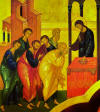The Byzantine Style
Example of Byzantine style painting and architecture (click to Enlarge)
The Byzantine Era Started from the Age of Justinian (527-565) and lasted until 1453
The Byzantine is a very easy style to identify, because of the stylized, rigid formality of the figures as well as the symmetrical folds of the draperies, which often show a sort of antiquated charm. The Byzantine style is not so much accurate representation but as a suggestion and symbolism. According to "It is noticeable in these Byzantine pictures that while the figure-painting is often really excellent, the design skilful, and the pose natural, the landscape, trees, etc., are quite symbolic and fanciful. The painters seem to have been utterly ignorant of perspective. Buildings, too, without any regard to relative proportion, are colored merely as parts of a colour scheme. They are pink, pale green, yellow, violet, blue, just to please the eye. That the painter had a system of colour-harmony is plain, but he paid no regard to the facts of city life, unless, indeed, it was the practice of the medieval Byzantines to paint the outside of their houses in this truly brilliant style. "The Byzantine period was tremendously culturally productive, in painting, sculpture, architecture and illuminated manuscripts. Artists emphasized transcendent time and place; the only worldly concern was with how one must behave in order to get into heaven. Thus the figures in Byzantine art tend to "hover" in space without weight and solidness, without inhabiting a three-dimensional space.
The monasteries owned vast libraries and engaged in the copying of manuscripts. Manuscript paintings were generally styled after classical paintings of late antiquity.
Byzantine mosaics are bedecked with gold leaf and iridescent glass tiles, radiating a shimmering, heavenly light. The effect of the composition together with the precious materials, lift the holy figures into a divine spiritual place. The figures themselves are symmetrical, repetitive, and little emotion or individualism is expressed in their calm faces.
Byzantine sovereigns adored gold in a sumptuous way, and on a grand scale. They had no use for simple, plain jewelry or furnishings. The royal thrones were made of solid gold; even their battle gear was festooned with jewels and gilded with gold and silver. Households of the upper class possessed a immense silver table, and solid silver tableware.
Throughout the life of the Byzantine Empire, the Eastern Orthodox Church also played an important social role. Sacred images, commissioned by the church acted as moral instruction to the illiterate peasants who clamored for enlightenment of the holy scriptures.
Until the twelfth century it had been the custom to
adorn the alters with costly religious reliquaries wrought in metal;
partly to preserve the metallic sheen of the decoration, partly because
of the contiguity of mosaics or stained glass, the paintings had to make
the most glittering impression possible. The figures, therefore, are
raised like mosaics from a gold background. Red, blue , and gold are the
prevailing colors. The figures also have the solemnity of Byzantine
types. The head of the Madonna, with the large almond eyes and long,
pointed nose, and the indifferent manner in which she holds the Christ
Child with her elongated, bony hands. With the triumph of Christianity,
Byzantine artists aspired to reawaken the divine spirit of holy figures
rather than depict their physical qualities. Their luminous paintings
captured the spirit of the Bible and helped to popularize Christianity.
Not until the thirteenth century, in the works of Florentine master
Cimabue, is a
change perceptible. He looked to nature for inspiration rather than
intuition or mysticism. The Christ-child becomes more childish and
tender; and a soft inclination of the head of the
Madonna
shows that she hears the prayers of men and can bring help and gracious
forgiveness. The hard, sullen features are animated by softness and
charm, by human sentiment; and it is in this sense that
Vasari wrote
that through Cimabue more love had come into art. Byzantine style represented early
Christian culture and values as well as courtly splendor. The paintings
are complex; fraught with religious fervor and symbolism. Most
prominently featured are the holy symbols of the Christian faith--Christ,
The Apostles,
Saints,
The Cross,
Virgin Mary,
Chalice,
Keys,
The Anchor,
Wheat ,
The Good
Shepherd,
Animals, Fish,
Angels,
Birds,
Insects and
Satan
☼☼☼☼☼
Their unique style is a combination of depicting frontal simplicity,
sacred images, harmonious unity, together with precision in details. The
use of costly materials such as gold, precious stones and ivory
indicates the degree of wealth that was common during this period, and
attests to the sophistication of the Byzantine Society.
☼☼☼☼☼
Require more information about Byzantine Painting? Search Here If you have comment or would like to share an insight regarding The Effect of Black Death on Art and Artists in the Middle Ages, please submit your comment to the editor, via e-mail and if possible site the source. Thank you!
© HistoryofPainters.com If you like this page and wish to share it, you are welcome to link to it, with our thanks.
If you feel you have worthwhile information you would like to contribute we would love to hear from you. We collect essential biographical information and artist quotes from folks all over the globe and appreciate your participation. When submitting please, if possible, site the source and provide English translation. Email to millardmulch@gmail.com
'
copyright 20003 - historyofpainters.com
© HistoryofPainters.com If you like this page and wish to share
it, you are welcome to link to it, with our thanks.
